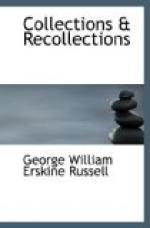The fifth Duke of Bedford (who had the temerity to attack Burke’s pension, and thereby drew down upon himself the most splendid repartee in literature) was a bosom-friend of Fox, and lived in a like-minded society. One night at Newmarket he lost a colossal sum at hazard, and, jumping up in a passion, he swore that the dice were loaded, put them in his pocket, and went to bed. Next morning he examined the dice in the presence of his boon companions, found that they were not loaded, and had to apologize and pay. Some years afterwards one of the party was lying on his death-bed, and he sent for the duke. “I have sent for you to tell you that you were right. The dice were loaded. We waited till you were asleep, went to your bedroom, took them out of your waistcoat pocket, replaced them with unloaded ones, and retired.”
“But suppose I had woke and caught you doing it.”
“Well, we were desperate men—and we had pistols.”
Anecdotes of the same type might be multiplied endlessly, and would serve to confirm the strong impression which all contemporary evidence leaves upon the mind—that the closing years of the eighteenth century witnessed the nadir of English virtue. The national conscience was in truth asleep, and it had a rude awakening. “I have heard persons of great weight and authority,” writes Mr. Gladstone, “such as Mr. Grenville, and also, I think, Archbishop Howley, ascribe the beginnings of a reviving seriousness in the upper classes of lay society to a reaction against the horrors and impieties of the first French Revolution in its later stages.” And this reviving seriousness was by no means confined to Nonconformist circles. In the eighteenth century the religious activities of the time proceeded largely (though not exclusively) from persons who, from one cause or another, were separated from the Established Church. Much theological learning and controversial skill, with the old traditions of Anglican divinity, had been drawn aside from the highway of the Establishment into the secluded byways of the Nonjurors. Whitefield and the Wesleys, and that grim but grand old Mother in Israel, Selina Countess of Huntingdon, found their evangelistic energies fatally cramped by episcopal authority, and, quite against their natural inclinations, were forced to act through independent organizations of their own making. But at the beginning of the nineteenth century things took a different turn.
The distinguishing mark of the religious revival which issued from the French Revolution was that it lived and moved and had its being within the precincts of the Church of England. Of that Church, as it existed at the close of the eighteenth century and the beginning of the nineteenth, the characteristic feature had been a quiet worldliness. The typical clergyman, as drawn, for instance, in Crabbe’s poems and Miss Austen’s novels, is a well-bred, respectable, and kindly person, playing an agreeable part in the




